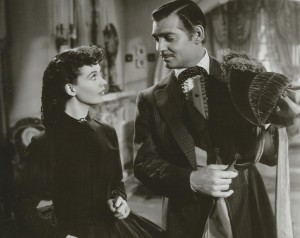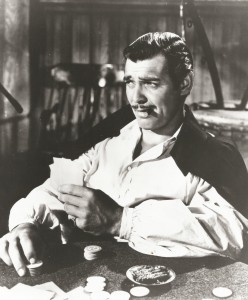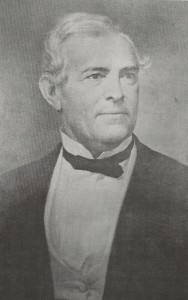Shipwreck Has Tie-in With the “Real Rhett Butler”

Clark Gable as Rhett Butler and Vivian Leigh as Scarlett O’Hara in Gone With The Wind
When biographer Darden Asbury Pyron wrote the life story about the renowned author of Gone With the Wind (Southern Daughter: The Life of Margaret Mitchell) he discovered close ties between real people and the characters in her 1936 epic. It’s believed that Mitchell’s characters were based on members and friends of her extended family and incidents in their lives, although she never admitted it for fear of being sued. One of her major characters—Capt. Rhett Butler—could have been George Alfred Trenholm, a handsome, rugged Charleston entrepreneur and backer of blockade runners.
Trenholm’s life is chronicled in Ethel Nepveux’s book, George Alfred Trenholm and the Company That Went to War, 1861-1865. Mrs. Nepveux, a Charleston historian and Trenholm’s great granddaughter says, “There were numerous resemblances between my great grandfather and Rhett Butler. I read and reread Gone With the Wind and Butler’s comments about blockade runners were exactly like those of George Alfred Trenholm. Mitchell must have researched my great grandfather’s career and used his background and personality to help shape Butler’s character.”

Clark Gable as Rhett Butler in Gone With The Wind
Nepveux believes the ties between Trenholm and Butler were too bona fide to be coincidental. Trenholm was a southern patriot whose money and knowledge of overseas trade enabled the Confederacy to jump-start the war effort by importing munitions, medicines and other vital necessities in exchange for millions of dollars worth of cotton. In a scene from the film, Scarlett infers that Rhett must have stolen large sums of money in his possession, but he explains that it came from sales of cotton and was earmarked for overseas bank accounts that funded the war effort. That was exactly how Trenholm operated.
Similarities between Butler and Trenholm appeared again in 1967 when divers salvaged cargo from the blockage runner, Georgiana, that further linked fiction to reality. The 14-gun emplacement vessel, running from Nassau, Bahamas, to Charleston, was the stoutest Confederate cruiser ever built. The powerful 407-ton, 200-foot-long steamer had a crew of 140 men, a clipper bow and a 150 HP engine. The 14 guns were scheduled to be mounted once the ship reached Charleston where it would become a fighting privateer.
On March 19, 1863, the Union yacht America spotted the Confederate cruiser outside Charleston Harbor and alerted the gunboat Wissahickson, whose captain maneuvered his vessel directly in the path of the blockade runner. Realizing he was trapped, the southern captain ordered full speed ahead toward the beach. When the vessel ran aground, three-fourths of a mile from shore, the skipper and his crew scuttled it and slipped away in longboats. The Wissahickson’s crew found the ship submerged in 14 feet of water. Fearing a return of rebel salvors, they set it afire and later learned of the valuable cargo left behind. Over the years, the blockade runner and its remaining cargo settled beneath tons of shifting sand and silk.

Was George Alfred Trenholm The Real Rhett Butler?
In 1967, divers working jointly with the Dept. of Archaeology, University of South Carolina, found the remains of the Georgiana. Although much of it was buried, the ship’s boiler, starboard side and iron deck supports protruded from the bottom. Working in almost zero visibility, the divers dug their way to the forward cargo hatch and discovered some small intact cargo crates. Among the discoveries were medicines, munitions, buttons, pencils, plates and straight pins. Over one million of the latter, all brass, were part of the cargo sorely missed by southerners who were waiting eagerly for them.
The pins, a seemingly insignificant item, were scarce and in demand. Scarlet O’Hara—in a dramatic scene from GWTW–begs Capt. Butler to get them past the blockade for her. Ironically, Trenholm owned a blockade runner, the Georgia, whose manifest included millions of pins.
Although it may never be proven, the ties branding George Alfred Trenholm and Capt. Rhett Butler as one and the same are there for GWTW fanciers to peruse. As for those who “frankly don’t give a damn,” well “fiddle-dee dee,” time marches on and “tomorrow’s another day.”
7 Comments
Submit a Comment
All Rights Reserved © | National Underwater and Marine Agency
All Rights Reserved © | National Underwater and Marine Agency
Web Design by Floyd Dog Design
Web Design by Floyd Dog Design

That is a very interesting story and I do believe that Alfred Trenholm was the real Rhett Butler. Did divers ever go back to the Georgiana after they discovered it in 1967?
Thank you very much. I never heard anything about divers returning to the Georgiana. I believe everything that’s left would be buried deep in the sand. However, sometimes Un. of North Carolina students, majoring in underwater archaeology, attempt such salvage. The wreck belongs to the state and a permit would be necessary.
I knew a little bit about Gone With the Wind, but not a whole lot. Your article inspired me to read the book and I found it fascinating. And your article made it much more interesting, cnsidering the possibility that Rhett Butler was possibly taken from a true life life figure. The shipwreck tie-in made it even more interesting. Thank you!
I have known Ellsworth Boyd for a great many years, so I find it it extremely odd that he would fail to credit me by name for my discovery. And, since I worked on the “Georgiana” off and on in the 1960s and 1970s, and much had been published about my work, including a 1976 article in “Skin Diver” magazine, for which Ellsworth was an editor, I was surprised to read in his reply to a reader’s question that he had “never heard anything about divers returning to the Georgiana.”
I am also puzzled why Ellsworth would say that “divers working jointly with the Dept. of Archaeology, University of South Carolina, found the remains of the Georgiana,” as they had absolutely nothing to do with the discovery and did none of the archaeology and recovery work. They never dove with us a single time. The actual name of that department is the South Carolina Institute of Archaeology & Anthropology (aka SCIAA), and the first time SCIAA made a dive on the “Georgiana” was over 40 years after my discovery of that wreck. A letter from Andrew H. Brown, Assistant Editor, “National Geographic Magazine,” written shortly after my discovery of the wreck stated “We (the editors) all agree that the amazingly intact cargo of the ‘Georgiana’ makes it a vessel of special interest.”
In his article, Ellsworth writes that Darden Asbury Pyron “discovered close ties between real people and the characters in her 1936 epic.” And, I don’t understand why he would credit Pyron, as though he was the discoverer of those “close ties.” I say that because in 1989 I became the first person to publicly make the connection that Rhett Butler was largely based on George Alfred Trenholm, and I supported that by simultaneously showing how numerous other characters in Mitchell’s novel were based on real people who interacted with Trenholm.
Ellsworth correctly mentions that Trenholm’s life is chronicled in Ethel Nepveux’s book, “George Alfred Trenholm and the Company That Went to War, 1861-1865,” which was first published in 1973. Her book predates my 1989 announcement, but it made absolutely no mention of Rhett Butler or any other connection to “Gone With The Wind.” The first time Mrs. Nepveux ever heard of and understood the connection was when Dr. Robert R. Nielson and I showed her some of my research in 1989. After reading it, she told us that she didn’t know why she had never made the connection before.
The 1989 announcement of my discovery, which was backed up by years of research, made international news, with headlines like this one in “The Philadelphia Daily News” — “Frankly Margaret, He’s Unmasked Rhett Butler.” And, my discovery resulted in my being an official guest at the 50th Anniversary celebrations of the release of the movie “Gone With The Wind.” “Life” magazine paid me thousands of dollars for the right to use part of the story. Norman Mailer, an American novelist who twice won a Pulitzer Prize, wrote me a letter stating “But hell, Rhett Butler is part of all our lives and so, of course, I can enjoy the unveiling.”
My 1995 book “Treasures of the Confederate Coast: The Real Rhett Butler and Other Revelations,” copies of which I gave Clive Cussler and others at NUMA, told about my discoveries and resulted in major articles about Trenholm, as the real Rhett Butler, being published in newspapers and magazines around the world.
You can read more about these and other of my discoveries on my shipwrecks dot com website.
Both my discoveries (that of the “Georgiana,” and that of the real people behind Rhett and other characters in GWTW) are well documented, and long predate anyone else’s alleged discoveries, so I ask why is Ellsworth Boyd and NUMA (since his article is on their website) crediting others and not me?
Thank you. I found this story to be one of the most interesting of the many I have researched. Being a fan of the film and its stars made it even more interesting.
Dr. Spence,
I found your articles absolutely fascinating. Being both a die-hard Gone With The Wind fan and a lover of Civil War history, it seemed impossible that Rhett Butler was no more than an illusion dreamed up by a very colorful author, Margaret Mitchell. He was too real, and you proved it! Is there one article, book or publication that contains all of your exhaustive research and comparison of the real life George Trenholm and Rhett Butler?
One of the best parts of my recent Charleston visit was our bus tour’s answer to my question about where was Rhett’s house (tongue in cheek) and he answered “Ashley House!” I was astounded and am now on a search for more info on george Trenholm. I always marveled at Mitchell’s imagination; what a clever lady she was. And a great researcher.